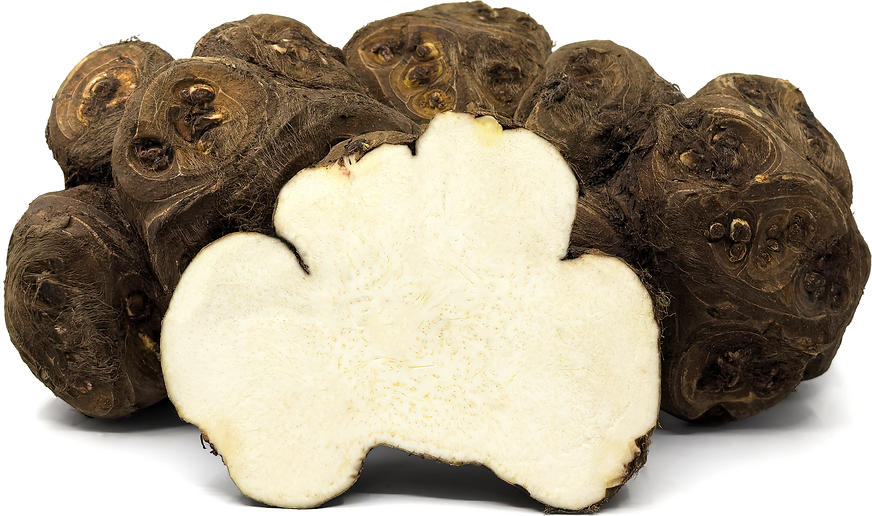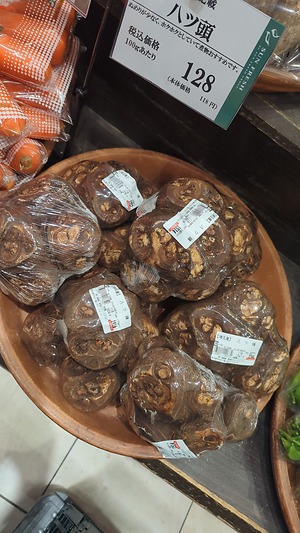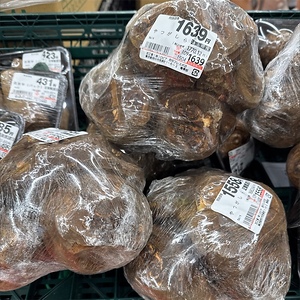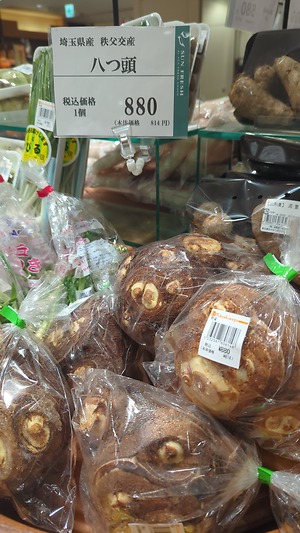


Yatsugashira Taro
Estimated Inventory, lb : 0
Description/Taste
Yatsugashira taro is generally large, averaging 10 to 15 centimeters in diameter, but can widely vary in size and shape depending on growing conditions. The underground corms feature a central, main rhizome covered in 3 to 9 smaller rhizomes that have fused together, creating a misshapen, lumpy, and irregular appearance. The corm mostly features rounded, curved edges and weighs anywhere from 500 grams to 1 kilogram. The corm's skin is semi-thick, rugged, and hard with a fibrous, craggy, and rough feel. The skin also ranges in color from dark brown, brown, tan, to orange-brown. Underneath the surface, the white to ivory flesh is dense, firm, and solid with a powdery consistency. Yatsugashira taro must be cooked before consumption, developing a soft and fluffy texture when heated. This variety has a higher sugar content than other taro cultivars, contributing to a sweeter taste. Select Yatsugashira taro that has a plump, heavy nature and a moist feel to the skin. If the skin is dry and brittle, it may indicate that the flesh has dried out and lost its flavor. Peeled and cooked Yatsugashira taro has a mild, earthy, subtly sweet, and faintly nutty taste.
Seasons/Availability
Yatsugashira taro is available in the winter through early spring.
Current Facts
Yatsugashira taro, botanically classified as Colocasia esculenta, is a Japanese variety belonging to the Araceae family. The large, bulbous corm is a series of smaller rhizomes fused to the central rhizome, creating an unusually shaped variety. Yatsugashira taro is valued for its sweet taste, fluffy consistency when cooked, and distinct appearance. The corms reach their peak season in the mid-winter in Japan and are released by growers as a famous specialty ingredient for traditional New Year culinary recipes. In commercial markets, there are two types of Yatsugashira, an ancient type that appears bumpy and irregularly shaped to a modern corm with a more round and smooth nature. Both types can be used in the same way for culinary dishes, but the smooth and more rounded cultivar is faster and easier to prepare. Yatsugashira taro has remained a staple ingredient for dishes served among family and friends throughout the New Year celebrations in Japan. After the holiday, Yatsugashira taro can also be grown as a houseplant, adding ornamental value to home décor.
Nutritional Value
Yatsugashira taro is a source of potassium to balance fluid levels within the body, fiber to regulate the digestive tract, and calcium to build strong bones and teeth. The corms also provide iron to develop the protein hemoglobin for oxygen transport through the bloodstream, vitamin C to strengthen the immune system while reducing inflammation, phosphorus to repair tissues, and other nutrients, including vitamin E, manganese, magnesium, and zinc. Beyond vitamins and minerals, taro plants contain oxalates, which are naturally occurring compounds that may cause kidney stones and skin irritation if contact is made when raw. These compounds are reduced when boiled.
Applications
Yatsugashira taro has a neutral, subtly sweet, and faintly nutty taste suited for cooked preparations. Taro must be cooked before consumption and is considered toxic when raw due to the presence of oxalates in the plant. The corms should be sliced into smaller pieces and peeled before cooking, and the flesh is primarily boiled, simmered, or fried. In Japan, Yatsugashira is typically boiled and served in salads. The cooked flesh can be tossed with mayonnaise, salt, and pepper in a dish resembling a potato salad or coated in a mixture of garlic and anchovies and served with vegetables. The corms are also boiled as a simple side dish, flavored with salty-sweet soy sauces, sake, sesame seeds, or light garlic sauces. Cooked Yatsugashira has a soft and fluffy texture that holds its shape well. The flesh can be deep fried as a crunchy snack, cooked, molded into balls and fried into croquettes, cooked into gravy-based curries, or served in miso soup. Yatsugashira taro can also be boiled, mixed with sugar and cream, and colored with purple yam, broccoli, or pumpkin powder to create a colorful mochi-like dish. Historically in Japan, taro corms were once tied around the waists of soldiers and eaten as emergency food during the civil wars throughout the Sengoku period from 1467 to 1568 CE. In addition to the corms, the tender purple-red stems above ground, known as the petiole and zuki, can be harvested, cooked, and served in traditional dishes. The stems are viewed as an ingredient to cleanse the blood and are often consumed among families who grow the taro plant in rice paddy fields. Yatsugashira taro pairs well with vegetables such as carrots, daikon radish, mushrooms, and broccoli, greens including mustard spinach, mitsuba, and seaweed, flavorings such as soy sauce, tamari, mirin, and sake, citrus including yuzu, and nuts such as walnuts. Whole, unwashed Yatsugashira taro should be kept with soil still covering the surface and wrapped in newspaper in a dark, cool, and ventilated location. The corms will keep for several weeks to months, depending on storage conditions.
Ethnic/Cultural Info
Yatsugashira taro translates from Japanese to mean "eight heads" and earned its name from its unusual appearance. Yatsugashira taro is comprised of a central corm with many small corms growing as offshoots of the central rhizome. The smaller corms remain attached to the central corm, resembling tiny heads, forming a large and bulbous mass considered auspicious for New Year celebrations. Taro, in general, is regarded as an ingredient that welcomes prosperity, and Yatsugashira is a variety viewed as a symbol of a connected family with offspring. The lumpy corm is also viewed as a symbol of "spreading from one point" and "the ability to get ahead," and consuming the corm over New Year's is said to bless a family to succeed, continue to grow, and increase prosperity in the year to come. Yatsugashira taro is most famously served in ozoni, a mochi-like soup traditionally prepared during Osechi Ryori, a Japanese New Year's feast. Ozoni is one of the most important foods within Osechi Ryori and is customarily served in the morning on New Year's Day. There are many variations of ozoni throughout Japan, and within Kansai style, the corms are incorporated into a white miso soup flavored with a kombu base dashi. Yatsugashira taro is cooked and formed into round mochi and served in a light broth with vegetables and bonito flakes. Ozoni can be traced back to the Heian Period, from 794 to 1192 CE, and it was once a favored dish to give as offerings to Buddha over New Year.
Geography/History
Yatsugashira taro is native to Asia and has been growing wild since ancient times. Experts believe the species is a descendant of ancient forms of taro that arose out of Southeast Asia and regions of Southern Asia. Taro is one of the earliest crops to be domesticated in Asia, and over time, the corms were carried into East Asia, where they were planted and cultivated in China and Japan. Taro is thought to have been cultivated in Japan since the Jomon period, from 10,500 to 300 BCE, and was used as a filling, everyday ingredient for centuries. It is unknown when Yatsugashira was created from introduced taro varieties in Japan, but taro was extensively cultivated up until the introduction of the sweet potato and potato in the Edo period from 1603 to 1868 CE. After the potato's rise in cultivation during the Edo period, taro varieties began to fade from popularity, and the corms were reserved for specific celebrations and recipes. In 2002, a natural mutation of Yatsugashira was discovered in Saitama City in the Saitama Prefecture. This mutation created a uniform, round corm, allowing the taro to be quickly peeled and prepped, a trait not found in original types of Yatsugashira. The Horticultural Research Institute of Saitama Prefectural Agriculture and Forestry Research Center selected the mutation as a new, improved variation of Yatsugashira, and the round-shaped corm was released and sold in commercial markets under the name Marukei Yatsugashira in 2012. By 2014, Marukei Yatsugashira was trademarked and primarily grown in Fukaya City. Today Yatsugashira taro is commercially produced on a small scale in Japan's Ibaraki, Chiba, and Saitama prefectures. The unusually shaped taro is sold for a limited season in the winter and is found through select growers, retailers, and distributors in Japan.










